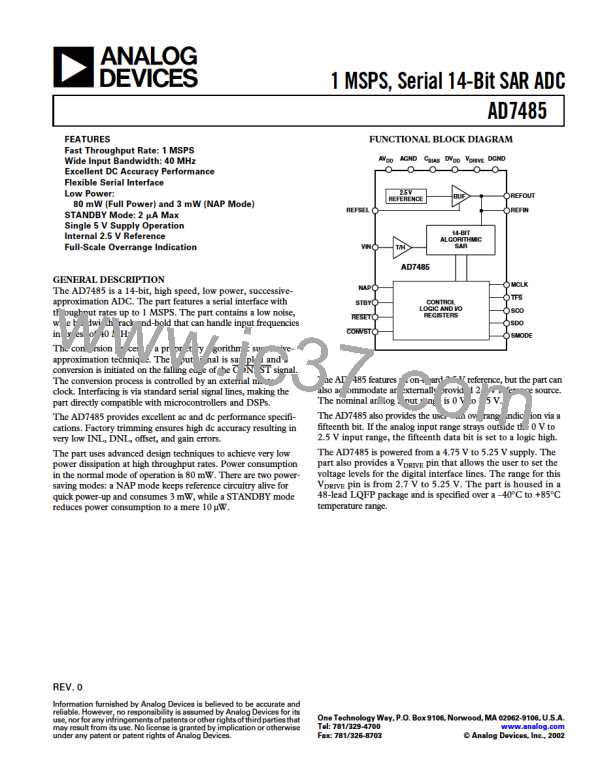AD7485
TERMINOLOGY
Total Harmonic Distortion
Integral Nonlinearity
Total harmonic distortion (THD) is the ratio of the rms sum
of the harmonics to the fundamental. For the AD7485, it is
This is the maximum deviation from a straight line passing
through the endpoints of the ADC transfer function. The end-
points of the transfer function are zero scale, a point 1/2 LSB
below the first code transition, and full scale, a point 1/2 LSB
above the last code transition.
defined as:
2
V22 +V32 +V4 +V52 +V62
THD dB = 20 log
(
)
V
1
where V1 is the rms amplitude of the fundamental and V2, V3,
V4, V5, and V6 are the rms amplitudes of the second through
sixth harmonics.
Differential Nonlinearity
This is the difference between the measured and the ideal
1 LSB change between any two adjacent codes in the ADC.
Peak Harmonic or Spurious Noise
Peak harmonic or spurious noise is defined as the ratio of the
rms value of the next largest component in the ADC output
spectrum (up to fS/2 and excluding dc) to the rms value of the
fundamental. Normally, the value of this specification is deter-
mined by the largest harmonic in the spectrum, but for ADCs
where the harmonics are buried in the noise floor, it will be a
noise peak.
Offset Error
This is the deviation of the first code transition (00 . . . 000) to
(00 . . . 001) from the ideal, i.e., AGND + 0.5 LSB.
Gain Error
This is the deviation of the last code transition (111 . . . 110) to
(111 . . . 111) from the ideal (i.e., VREF – 1.5 LSB) after the
offset error has been adjusted out.
Intermodulation Distortion
Track/Hold Acquisition Time
With inputs consisting of sine waves at two frequencies, fa and fb,
any active device with nonlinearities will create distortion products
at sum and difference frequencies of mfa nfb where m, n = 0, 1, 2,
3, and so on. Intermodulation distortion terms are those for which
neither m nor n is equal to zero. For example, the second-order
terms include (fa + fb) and (fa – fb), while the third-order terms
include (2fa + fb), (2fa – fb), (fa + 2fb), and (fa – 2fb).
Track/hold acquisition time is the time required for the output
of the track/hold amplifier to reach its final value, within 1/2 LSB,
after the end of conversion (the point at which the track/hold
returns to track mode).
Signal to (Noise + Distortion) Ratio
This is the measured ratio of signal to (noise + distortion) at
the output of the A/D converter. The signal is the rms amplitude
of the fundamental. Noise is the sum of all nonfundamental
signals up to half the sampling frequency (fS/2), excluding dc.
The ratio is dependent on the number of quantization levels in
the digitization process; the more levels, the smaller the quanti-
zation noise. The theoretical signal to (noise + distortion) ratio
for an ideal N-bit converter with a sine wave input is given by:
The AD7485 is tested using the CCIF standard where two
input frequencies near the top end of the input bandwidth are
used. In this case, the second-order terms are usually distanced
in frequency from the original sine waves while the third-order
terms are usually at a frequency close to the input frequencies.
As a result, the second- and third-order terms are specified
separately. The calculation of the intermodulation distortion
is as per the THD specification where it is the ratio of the rms
sum of the individual distortion products to the rms amplitude
of the sum of the fundamentals expressed in dBs.
Signal to (Noise + Distortion) = 6.02 N + 1.76 dB
(
)
Thus, for a 14-bit converter this is 86.04 dB.
–6–
REV. 0

 AMICC [ AMIC TECHNOLOGY ]
AMICC [ AMIC TECHNOLOGY ]